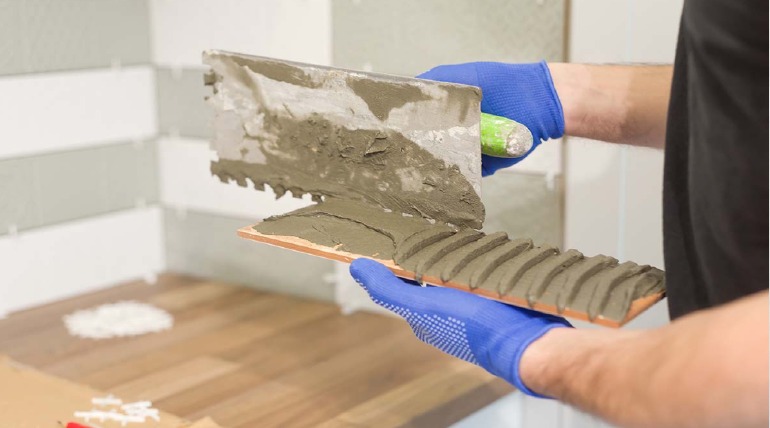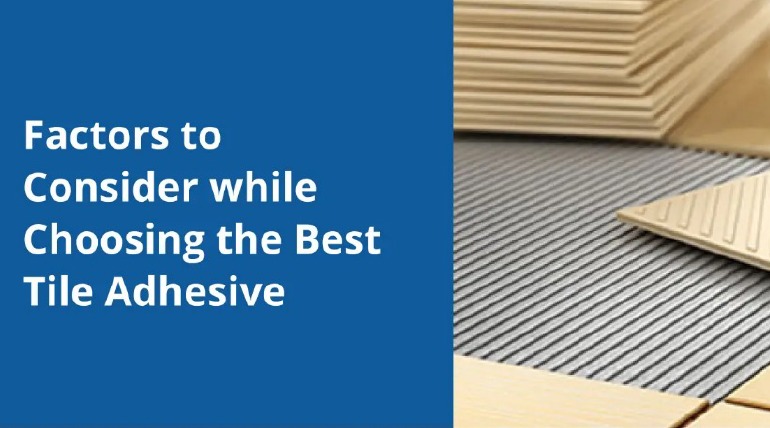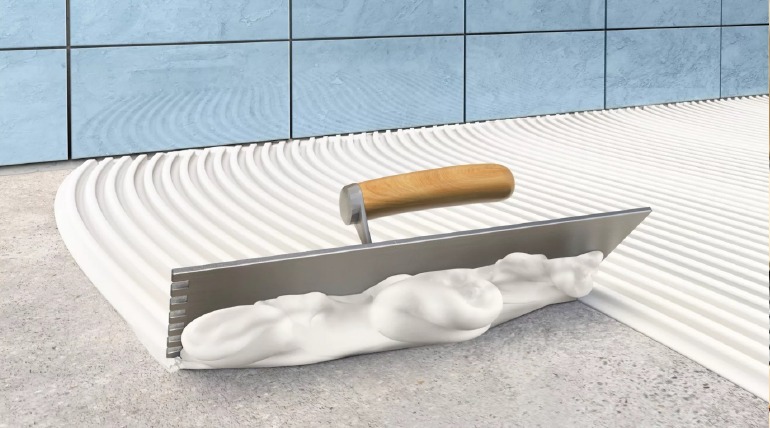
In modern construction, tile adhesives have transformed the way tiles are installed, ensuring stronger bonding, faster application, and long-lasting finishes. However, the success of any tiling project depends on two key factors—choosing the right adhesive and applying it correctly.
 What is Tile Adhesive?
What is Tile Adhesive?

Tile adhesive is a specially engineered, polymer-modified cementitious or epoxy or pre-modified epoxy material formulated to bond tiles securely to various surfaces. Unlike conventional sand-cement mixtures, modern tile adhesives provide exceptional bonding strength, enhanced flexibility, and superior resistance to water, heat, and environmental stress—ensuring that tiles remain firmly in place for years to come.
These adhesive forms a strong, uniform connection between tiles and substrates—whether walls, floors, or vertical or horizontal —preventing issues such as cracks, hollow spots, or tile displacement over time. By evenly distributing the weight of the tiles, it ensures a smooth, level finish without the risk of uneven settling.
Beyond bonding, many advanced tile adhesives also offer water-resistant properties, making them ideal for moisture-prone areas like bathrooms, kitchens, balconies, and swimming pools. Some formulations incorporate flexibility, allowing them to absorb minor substrate movements without causing debonding or cracks. This makes them particularly effective in high-traffic areas and structures subject to thermal expansion and contraction or structural swing / Vibration.
 What Role Does It Play in Tile Fixing?
What Role Does It Play in Tile Fixing?
• Provides strong and durable bonding between tiles and surfaces.
• Prevents tile debonding and cracking by offering flexibility.
• Reduces hollow sounds and uneven surfaces.
• Allows for thin-bed applications, minimizing material use & wastage.
• Ensures faster installation and cleaner finishes.
 Choosing the Right Adhesive for Different Types of Tiles
Choosing the Right Adhesive for Different Types of Tiles

Selecting the correct tile adhesive is critical to the success and durability of your tile installation.
Adhesive Types by Composition:
• Cementitious Adhesives: Ideal for standard tile applications; easy to mix and apply.
• Reaction-Based Adhesives (Epoxy/Polyurethane): Best for areas requiring high chemical resistance, superior waterproofing, or the ability to withstand heavy loads. These adhesives offer excellent flexibility and are suitable for metal, wood, and other demanding surfaces.
Adhesive Types by Classification:
• Cementitious Type 1: Suitable for interior wall & floor applications. For the tiles having > 3% absorption.
• Cementitious Type 2: Suitable for interior wall/ floor & exterior floor application for tiles having < 3% absorption (e.g., vitrified tiles and natural stone), + application of Type 1.
• Cementitious Type 3: Ideal for outside wall/ Exterior wall applications+ application of Type 1 & Type 2.
• Cementitious Type 4: Suitable for all 3 Types 1, 2 & 3 + various substrates.
• Epoxy/ PU adhesive Type 5: High-performance adhesives designed for exterior facades, submerged areas (like swimming pools), and large format tiles.
By carefully considering these factors, you can ensure your tile installation is not only durable but also perfectly suited to the specific requirements of your project.
 Correct Application of Adhesive to Achieve the Best Results
Correct Application of Adhesive to Achieve the Best Results

1. Surface Preparation:
- Ensure the surface is clean, level, and free from any loose particles and grease/ oil.
2. Plan the Layout:
- For a balanced and visually pleasing outcome, carefully plan your tile arrangement.
- Measure and mark the centreline of the surface, and dry-lay the tiles along this line without adhesive to visualize the pattern.
- Make any necessary adjustments before proceeding to achieve symmetry and minimize awkward cuts at edges.
3. Check the Levelness of the Wall or Floor:
- Before tiling, it’s crucial to ensure the surface is perfectly level to avoid gaps or uneven tile placement.
- Use a long carpenter’s level to check multiple points across the surface—both vertically and horizontally.
- Depending on the project size, choose a small or large level for greater accuracy and make adjustments as needed.
4. Mixing the Adhesive:
- Gradually add adhesive powder to the clean water and mix until a smooth, lump-free consistency is achieved.
- Let it rest for 5–10 minutes, then remix before application.
5. Applying the Adhesive:
- Spread the adhesive on the substrate & tile back evenly using a 6 mm notched trowel at a 35 – 45 degree angle to create uniform ridges (crossways).
- Apply only as much adhesive as can be tiled within the open time (Recommended by the manufacturer) of the tile adhesive to prevent surface drying.
6. Laying the Tiles:
- Press tiles firmly with a slight twisting motion. To eliminate air pockets, use a metal or wooden hammer from outer to outside in a circular motion.
- Use spacers for even grout joints and check alignment regularly with a level.
7. Curing & Grouting:
- Allow a minimum of 24 hours for the adhesive to set before grouting.
- Apply grout, clean excess with a damp sponge, and polish for a perfect finish.
Tile Adhesive Classification & Technical Comparison
Choosing the correct tile adhesive is not just about application ease—it must be tailored to the type of tile, substrate, environment, and performance expectations. Below is a comparative summary of tile adhesive types as per IS standards, covering their ideal use cases, technical specifications, and compatibility.
This table also maps each type to HomeSure TileEx products, helping you select the perfect solution—whether you’re working with vitrified tiles, natural stone, external facades, or submerged installations.

 Expert Recommendation
Expert Recommendation
For flawless tile installations that stand the test of time, trust the HomeSure TileEx Range by Walplast. Whether it’s interiors or exteriors, small ceramic tiles or large vitrified slabs, wet areas or submerged installations. HomeSure TileEx tile adhesive offers a specialized solution for every tiling challenge with its extensive portfolio from EX11, EX 22, EX 33, EX 44, EX 55.
